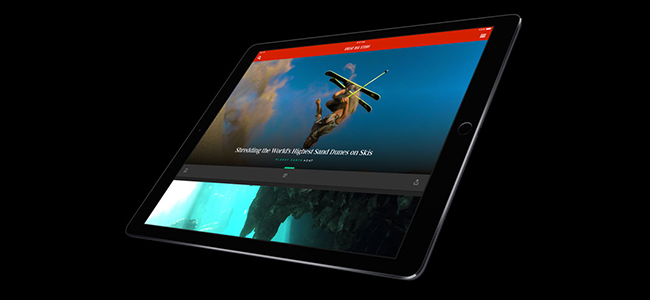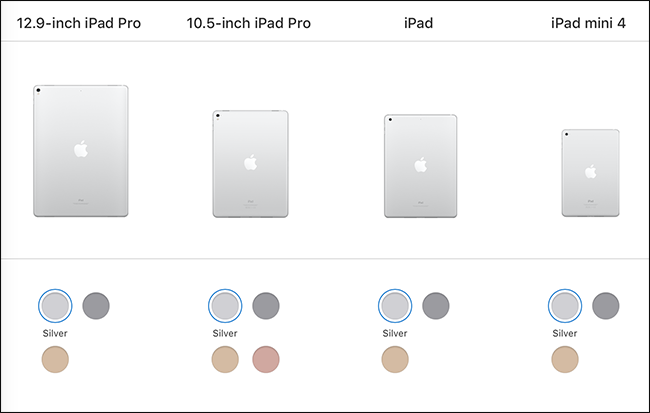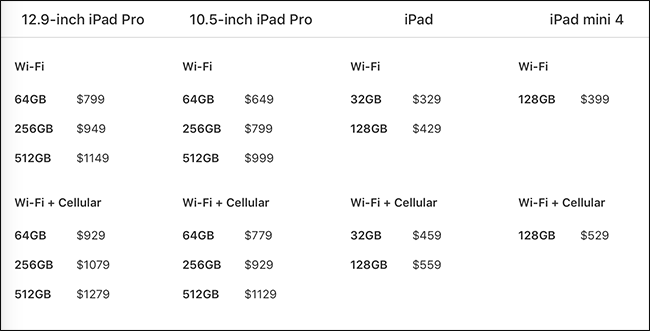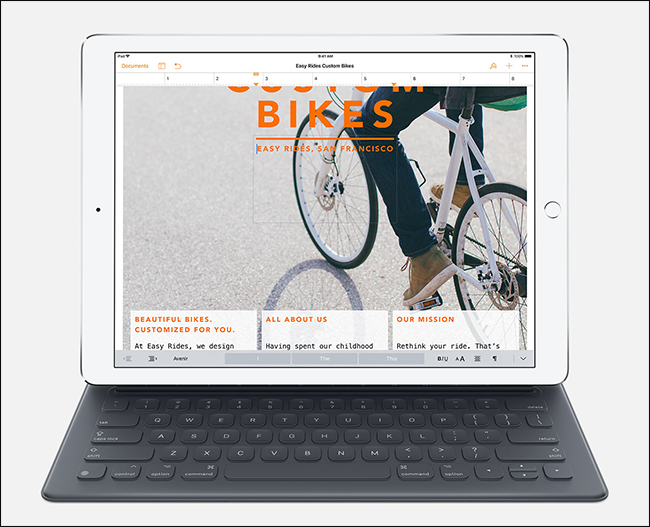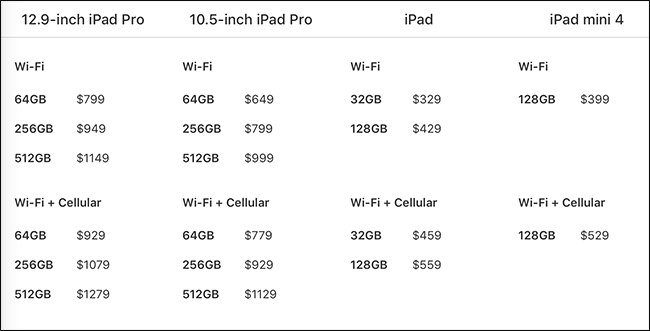Quick Links
Apple’s iPad line has gotten pretty hefty, between the 12.9-inch and 10.5-inch iPad Pro, the (blandly named) iPad, and the iPad Mini 4. They range from $329 all the way up to $1279. So what’s the difference between all these models? Let’s take a look.
What’s the Same?
Before diving into the nitty gritty, let’s consider what’s broadly the same.
They’re all iPads running Apple’s iOS operating system. The vast majority of apps will run smoothly on all four models (though some games may not run smoothly or even be available for the iPad Mini 4).
All the models are available in Silver, Space Grey, and Gold. The 10.5-inch iPad Pro is also available in Rose Gold.
Each model is available as either a regular model with Wi-Fi, or one with Wi-Fi and Cellular (although if you want to use the Cellular feature, you’ll need to sign up to a data plan with a carrier).
Each model also has a Touch ID fingerprint sensor for security.
Lastly, Apple says each iPad has about 10 hours of battery life, regardless of which size, and charges using a Lightning cable.
The Display
The most immediately apparent difference between all the different iPad models is the size of the screen, and thus the size of the device. There are four different sizes:
- The 12.9” iPad Pro with a 2732‑by‑2048 screen.
- The 10.5” iPad Pro with a 2224‑by‑1668 screen.
- The 9.7” iPad with a 2048‑by‑1536 screen.
- The 7.9” iPad Mini 4 with a 2048‑by‑1536 screen.
The screens on the two Pro models use the wider P3 color gamut and also adjust the white balance of the screen so that it better matches the ambient light in the room (apple calls this feature " TrueTone"). They also have a higher refresh rate than the iPad and iPad Mini 4. Collectively, this means that the display on the two Pro models is significantly, and noticeably, better and smoother.
The CPU
The other big difference between the iPad Pro models and the iPad and iPad Mini 4 is the chip inside. The two iPad Pros have the A10X Fusion system-on-a-chip, while the iPad has the older A9 and the iPad Mini 4 has the even older A8.
This means that the iPad Pros are about 30% faster for single core performance and 80% faster for multi-core performance than the iPad. The iPad Pros also have about 150% faster CPU performance than the iPad Mini.
Again, you will see a difference between an iPad Pro and a regular iPad or iPad Mini 4. It will be faster at almost everything, though the difference will be most noticeable in things like games or professional applications. It’s not that the iPad and iPad Mini 4 are slow; it’s just that the iPad Pro is really, really fast.
Storage
Storage isn’t quite the concern it once was---the iPad is the only model offering less than 64GB. Even with the regular iPad, spending an additional $100 gets you a 128GB, which is a ton of space.
The iPad Mini 4 is, strangely, only available in 128GB, and the two iPad Pros come in three sizes: 64GB, 256GB, and 512GB.
Unless you want a huge amount of storage space, there is a decent option for every iPad. The 128GB iPad and iPad Mini 4 both have more than enough storage space for most uses; it’s only professionals working with high resolution photos and video who are likely to need the 256GB or 512GB Pro options.
Professional Accessory Support
Doing actual work with a touch screen is difficult. It can be done, but it’s not a lot of fun. To get major work done, you need a keyboard and/or a stylus (depending on your work).
Apple offers both a Smart Keyboard and an Apple Pencil, but they are only fully compatible with the two iPad Pros. The Pencil will work on a regular iPad or iPad Mini 4, but you won’t get pressure sensitivity, which kind of defeats the purpose of spending $99 on one.
That said, you can still find plenty of Bluetooth keyboards, keyboard cases, and styluses that work with the iPad and iPad Mini 4. They just won't be quite as integrated as Apple’s accessories are with the Pros, and they may not have quite as many features (like the aforementioned pressure sensitivity). But you can get by.
Camera and Audio
There are a host of differences between the iPad Pro, iPad, and iPad Mini 4 when it comes to camera and audio playback. Here are the ones you will notice:
- The iPad Pros have a 12-megapixel rear camera with a f/1.8 lens and optical image stabilization. The iPad and iPad Mini 4 only have 8-megapixel cameras with f/2.4 lenses.
- The iPad Pros can record 4K video. The iPad and iPad Mini 4 are limited to 1080p.
- The iPad Pros have a 7-megapixel FaceTime camera. The iPad and iPad Mini 4 only have a 1.2-megapixel FaceTime camera.
- The iPad Pros have four speakers; the iPad and iPad Mini 4 only have two.
The iPad and iPad Mini definitely aren't weak in this department---all of those specs are solid. Just take note if you really care about image stabilization, 4K video, or speakers.
The Price
It should be pretty clear by now that the iPad Pros are a different class of device to the regular iPad and iPad Mini 4. They’re better across the board. Their premium features, however, come at a premium price.
The two best cheap options—the 128GB Wi-Fi iPad and 128GB Wi-Fi iPad Mini 4—cost just $399 and and $429 respectively. That's a pretty accessible price point, and those devices will do well for a lot of people.
The iPad Pro starts at $649 for the 64GB Wi-Fi 10.5 inch iPad Pro. But if you’re getting a Pro, you’re realistically going to spend $99 on an Apple Pencil or $159 ($169 for the larger iPad Pro) on the Smart Keyboard, too. And if you're really using them for professional applications, 64GB of storage probably isn’t enough either for professional uses...so a lot of people will end up spending over $800 on an iPad Pro if you want all the bells and whistles.
That means realistically, the iPad Pro and its accessories can cost almost twice as much as the more basic iPads. It's worth it, but only if you're really going to take advantage of those features. Unless you’re sure you will use the iPad Pro as a work tool (or are a really heavy iPad gamer), you’re almost certainly better off with an iPad or iPad Mini 4. They are still powerful tablets with great displays that are more than capable of handling most modern apps.

